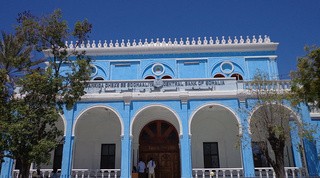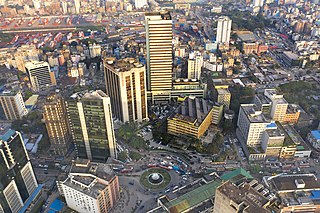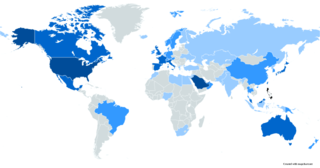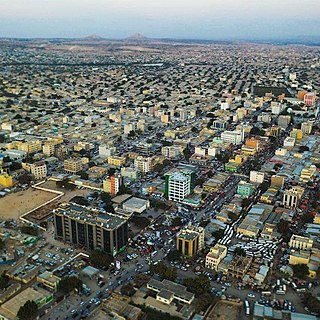Related Research Articles
Hawala or hewala, originating in India as havala, also known as havaleh in Persian, and xawala or xawilaad in Somali, is a popular and informal value transfer system based on the performance and honour of a huge network of money brokers. They operate outside of, or parallel to, traditional banking, financial channels and remittance systems. The system requires a minimum of two hawaladars that take care of the "transaction" without the movement of cash or telegraphic transfer. While hawaladars are spread throughout the world, they are primarily located in the Middle East, North Africa, the Horn of Africa and the Indian subcontinent. Hawala follows Islamic traditions but its use is not limited to Muslims.

The economy of Pakistan is categorized as a developing economy. It ranks as the 24th-largest based on GDP using purchasing power parity (PPP) and the 46th largest in terms of nominal GDP. With a population of 241.5 million people as of 2023, Pakistan's position at per capita income ranks 161st by GDP (nominal) and 138th by GDP (PPP) according to the International Monetary Fund (IMF).

Somalia is classified by the United Nations as a least developed country, with the majority of its population being dependent on agriculture and livestock for their livelihood. The economy of Somalia is $25.6 billion by gross domestic product as of 2024. For 1994, the CIA estimated it at purchasing power parity to be approximately $3.3 billion. In 2001, it was estimated to be $4.1 billion. By 2009, the CIA estimated that it had grown to $5.731 billion, with a projected real growth rate of 2.6%. In 2014, the International Monetary Fund estimated economic activity to have expanded by 3.7% primarily. This expansion was driven by growth in the primary sector and the secondary sector. According to a 2007 British Chambers of Commerce report, the private sector has experienced growth, particularly in the service sector. Unlike the pre-civil war period, when most services and the industrial sector were government-run, there has been substantial, albeit unmeasured, private investment in commercial activities. The investment has been largely financed by the Somali diaspora, and includes trade and marketing, money transfer services, transportation, communications, fishery equipment, airlines, telecommunications, education, health, construction and hotels.

The economy of Bangladesh is a major developing mixed economy. As the second-largest economy in South Asia, Bangladesh's economy is the 35th largest in the world in nominal terms, and 25th largest by purchasing power parity. Bangladesh is seen by various financial institutions as one of the Next Eleven. It has been transitioning from being a frontier market into an emerging market. Bangladesh is a member of the South Asian Free Trade Area and the World Trade Organization. In fiscal year 2021–2022, Bangladesh registered a GDP growth rate of 7.2% after the global pandemic. Bangladesh is one of the fastest growing economies in the world.
An informal value transfer system (IVTS) is any system, mechanism, or network of people that receives money for the purpose of making the funds or an equivalent value payable to a third party in another geographic location, whether or not in the same form. Informal value transfers generally take place outside of the conventional banking system through non-bank financial institutions or other business entities whose primary business activity may not be the transmission of money. The IVTS transactions occasionally interconnect with formal banking systems, such as through the use of bank accounts held by the IVTS operator.

A hundi or hundee is a financial instrument that was developed in Medieval India for use in trade and credit transactions. Hundis are used as a form of remittance instrument to transfer money from place to place, as a form of credit instrument or IOU to borrow money and as a bill of exchange in trade transactions. The Reserve Bank of India describes the hundi as "an unconditional order in writing made by a person directing another to pay a certain sum of money to a person named in the order."

An overseas Filipino is a person of full or partial Filipino origin who trace their ancestry back to the Philippines but are living and working outside of the country. They get jobs in countries, and they move to live in countries that they get jobs in, or if they want to migrate to somewhere else, This term generally applies to both people of Filipino ancestry and citizens abroad. As of 2019, there were over 15 million Filipinos overseas.

A remittance is a non-commercial transfer of money by a foreign worker, a member of a diaspora community, or a citizen with familial ties abroad, for household income in their home country or homeland.

The economy of Somaliland largely relies on primary production and agriculture, where livestock is the main export of the country, which it ships to neighbouring Djibouti and Ethiopia, as well as to Gulf states, such as UAE, Saudi Arabia and Oman. Somaliland has a GDP per capita of $1361 and a gross domestic product GDP of $7,583,000,000 as of 2024,The COVID-19 pandemic has restricted Somaliland's trade flows with decreased demand in the agriculture sector, a significant source of tax revenue.

The Central Bank of Somalia (CBS) is the monetary authority of Somalia. Somalia has struggled to reestablish a functioning state since the collapse of an authoritarian regime in 1991. Somalia has been cited as a real-world example of an anarchist stateless society and a country with no formal legal system. The Transitional Federal Government, formed in 2004, was recognized as the central government of Somalia. Among other duties, it is in charge of ensuring financial stability, maintaining the internal and external value of the local currency, and promoting credit and exchange conditions that facilitate the balanced growth of the national economy. Within the scope of its powers, it also contributes to the financial and economic policies of the State.
Money transfer generally refers to one of the following cashless modes of payment or payment systems:

Overseas Pakistanis, or the Pakistani diaspora, refer to Pakistanis who live outside of Pakistan. These include citizens who have migrated to another country as well as people born abroad of Pakistani descent. According to a December 2017 estimate by the Ministry of Overseas Pakistanis and Human Resource Development, approximately 8.8 million Pakistanis live abroad. Data released in 2023 by the Ministry of Emigration and Overseas Employment states that more than 10.80 million people have moved abroad since 1990.
Bangladeshis in Japan form one of the smaller populations of foreigners in Japan. As of in June 2023, Japan's Ministry of Justice recorded 24,940 Bangladeshi nationals among the total population of registered foreigners in Japan.

Pakistan and Saudi Arabia established relations in 1947, when Pakistan became independent from British rule. Relations have been historically close and friendly, frequently described by analysts as constituting a special relationship. Pakistan has sometimes been dubbed as "Saudi Arabia's closest Muslim and non-Arab ally." Pakistan has, in line with its pan-Islamic ideology, assumed the role of a guardian of Saudi Arabia against any external or internal threat.
Remittances to India are money transfers from non-resident Indians (NRIs) employed outside the country to family, friends or relatives residing in India. India is the world's top receiver of remittances, claiming more than 12% of the world's remittances in 2015. Remittances to India stood at US$125 billion in 2023, up from US$69 billion in 2017. Remittances from India to other countries totalled US$5.710 billion in 2017, for a net inflow of US$63.258 billion in 2017.

The Bangladeshi diaspora are people of Bangladeshi birth, descent or origin who live outside of Bangladesh. First-generation migrants may have moved abroad from Bangladesh for various reasons including better living conditions, to escape poverty, to support their financial condition, or to send money back to families there. The Ministry of Expatriates' Welfare and Overseas Employment estimates there are almost 7.5 million Bangladeshis living abroad, the fourth highest among the top 176 countries of origin for international migrants. Annual remittances transferred to Bangladesh were almost $23 billion in 2023, the seventh highest in the world and the third highest in South Asia.
Indians in Bangladesh are the citizens of India living in Bangladesh. Citing the results of a survey, a column in The Financial Express reported that as many as 500,000 Indians were staying illegally in Bangladesh in 2009. The article claims that they were found working in different establishments such as NGOs, garments, textile, and IT, and sent money back home through hundi transfer systems. According to Daily Industry, there may have been one million Indians in Bangladesh illegally in 2022.

The Ministry of Expatriates' Welfare and Overseas Employment is a ministry of the government of the People's Republic of Bangladesh. It provided information, partnerships and facilitations for all matters related to overseas Bangladeshis and overseas employment. Overseas employment is very important in the socio-economic context of Bangladesh. Employment abroad not only reduces the country's unemployment, but also the remittances sent by expatriates working abroad keep the wheels of the country's economy moving. On 20 December 2001, the Government of Bangladesh established a separate Ministry of Expatriate Welfare and Foreign Employment, giving increased importance to the field of foreign employment. The purpose of forming this ministry is to ensure the welfare of expatriate workers and expand foreign employment. The Ministry has been working to ensure the welfare of all migrant workers by increasing the flow of remittances and creating opportunities of securing overseas employment for workers from all regions of the country.
International money transfers made by migrant workers and immigrants sending a portion of their earnings to their families in their country of origin are known as remittances. Remittances are an important aspect of the global economy, totaling an estimated $601 billion (USD) for the year 2015. The United States is currently the largest source of international remittances in the world, sending a total of $148 billion in 2017. Mexico received the largest portion of these remittances, accounting for more than $30 billion USD. making the U.S.-Mexico remittance corridor one of the largest in the world. With the exception of the 2008 global financial crisis, remittances sent from the U.S. have been consistently climbing for the past half century. This major increase in remittances can be partially attributed to the larger population of immigrants and migrant workers, as well as to increasing globalization in the financial and money markets. China and India are also major recipients of U.S. remittances, and are the top two recipients of remittances globally.
Banking in Guyana follows the country's tumultuous economics history, from formal introduction under British rule, the socialist-oriented nationalization of banks at independence, to IMF sponsored open-market initiatives. The banking industry faces increased pressure to meet global standards domestically, as well as attract international investors, and serve the large number of diaspora that remain economically tied to the country.
References
- ↑ "Bangladesh 7th highest remittance recipient: World Bank". The Daily Star . 2022-05-13. Retrieved 2022-06-12.
- ↑ "Bangladesh's remittance inflow hits record high in 2021". New Age. 2022-01-02. Retrieved 2022-06-12.
- ↑ Saha, Sanjoy Kumar (24 September 2021). "The Impact of Remittance on Economic Growth in Bangladesh" (PDF). Scholars Journal of Arts, Humanities and Social Sciences. 10.36347/sjahss.2021.v09i09.013.
- ↑ "Utilisation of Workers' Remittances in Bangladesh" (PDF). Bangladesh Bank. Research Department Bangladesh Bank. November 2017. Retrieved August 6, 2020.
- ↑ "Overview". World Bank. Retrieved 2023-08-19.
- 1 2 3 Bangladesh Economic Update: Remittance, 8 September 2011, Unnayan Onneshan, Dhaka, p. 9.
- ↑ "From transit passenger to business tycoon". Khaleej Times. Retrieved 30 March 2017.
- ↑ "Country-wise Inward Remittances". Bangladesh Bank. Retrieved 2019-09-27.
- ↑ "2016 Statistical Yearbook" (PDF). Bangladesh Bureau of Statistics. May 2017. p. 110. Retrieved 2019-10-05.
- ↑ "Yearly data of Wage earner's remittance". Bangladesh Bank. January 2024. Retrieved January 8, 2024.